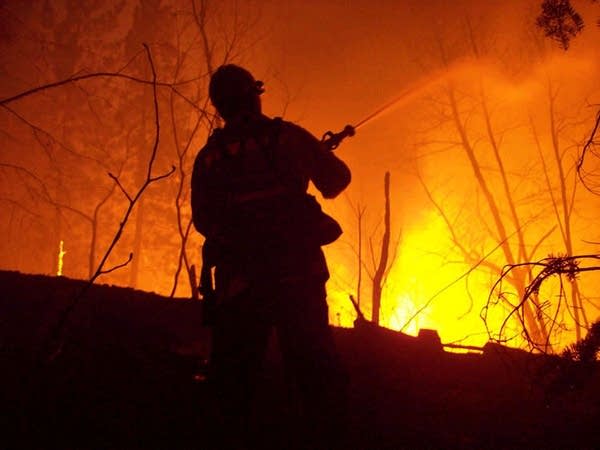Evacuation ordered in Gunflint Lodge area
Go Deeper.
Create an account or log in to save stories.
Like this?
Thanks for liking this story! We have added it to a list of your favorite stories.

This was a day fire officials had been dreading, and it turned out to be bad. They issued a "red flag" notice, which means the conditions present a fire hazard that's off the charts.
"We're in uncharted territory, rarely if ever seen here," said Steve Raddatz, who is in charge of the firefighting operations. "We're getting an alignment of temperature, humidity, wind velocity and wind direction that's all lined up to be the worst possible scenario for what we're trying to do."

Wednesday, Raddatz decided to conduct a "burnout" on the eastern flank of the fire. Crews purposely torched an area between Gunflint Lake and Magnetic Lake.
The idea was to deprive the fire of fuel Thursday, when the wind was projected to shift and push it in that direction. That manmade fire quickly gobbled up about 5,000 acres.
Turn Up Your Support
MPR News helps you turn down the noise and build shared understanding. Turn up your support for this public resource and keep trusted journalism accessible to all.
"That fire burned in very good. It made this line safe, because it eliminates fuels, including interior fuels, that could spot out and continue going," Raddatz explained.
But meanwhile, the blaze was roaring ahead to the south. Raddatz says the tinder-dry fuel does a good job of spreading the fire.
"If 10 embers land out ahead of fire, you're going to have at least eight of them start significant spot fires that get established and start running," Raddatz said. "Three days ago, they saw the fire move almost a mile every hour."

Late Thursday, black smoke covered the sky, hundreds of feet into the air. With the wind coming at 20 mph from the northwest, the fire was challenging the lines established by firefighters.
The Cook County Sheriff decided to evacuate people from the Gunflint, Loon, and Tucker Lakes area.
Near the rustic Gunflint Lodge, on the south side of Gunflint Lake, the smoke from the fire had turned the sky the deep slate blue of an incoming thunderstorm. Between the sky and the trees, there was a ribbon of glowing orange from the fire.
The lodge was founded in 1925 deep in the wilderness of northeastern Minnesota at what was then the end of the Gunflint Trail. It's remoteness was always part of its allure. Over the years it evolved from a rustic fishing resort to a luxury vacation destination, popular as a jumping off point for excursions into the nearby Boundary Waters Canoe Area.

Ardis David, 80, was eating at the lodge when the winds brought the fire within sight and the smoke rolled in overhead. "I've never seen a sky quite like that," she said. "Flames were coming off the ridge."
Gloria Johnson, 59, watched the sky darken while she was working at the Trail Center and Black Bear Bar and Restuarant, about midway down the Gunflint Trail.
"It's scary - not just for myself, but this is Cook County's livelihood," she said. "We depend on the tourists in the summer."
After looking at the ominous sky, Johnson said she was going to prepare to evacuate even though her house was still about six miles from the fire.
"We're nervous," she said, then began crying. "I'm emotional because I just lost my husband and so the thought of losing my house too is just too much."

On Thursday, the fire was burning an area that included parts of the BWCAW, Canada and private land.
People who have installed sprinkler systems around their homes and cabins are saving their property. Operations chief Steve Raddatz says the sprinklers have been very effective.
"[With the] fire behavior I saw two or three days ago, I wouldn't give some of those structures much of a chance, but with the sprinklers, and the work of the people around them, they survived," said Raddatz.
Only a couple of homes with sprinklers have burned. Dan Baumann, chief of the Gunflint Trail Volunteer Fire Department, says those had specific problems.

"Poor maintenance, broken lines from not draining them. One system, the pump was gone, they moved it and we couldn't find it," said Baumann. "These are little things we've learned to improve the next round, which you hope won't happen -- but you're proactive, you plan."
Baumann says the difference between the fire-ravaged surroundings and the sprinkled homes is dramatic.
"It's like a tropical forest," said Baumann. "There was one I went in, they had the sprinkler system, you walked in, it was cold, it was wet, you left your footprints in the ground. It definitely -- they're an oasis."
Thursday evening could get even more complicated for firefighters. Northwest winds will bring cooler temperatures and more humidity, but as long as they keep coming at 20 mph, the fire will keep growing.
(The Associated Press contributed to this report)



